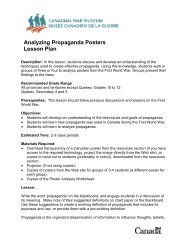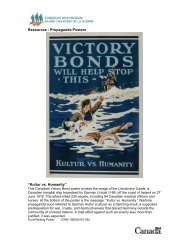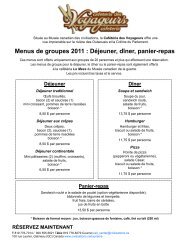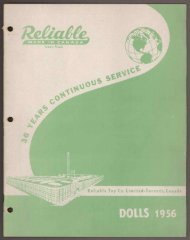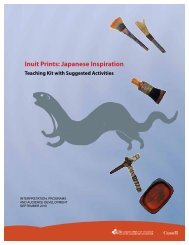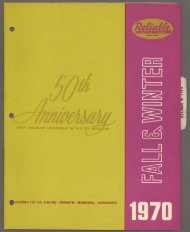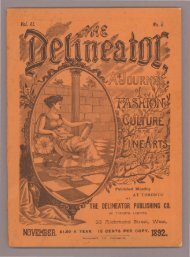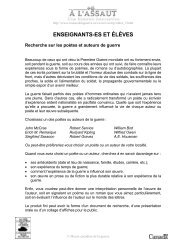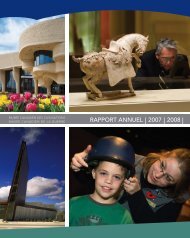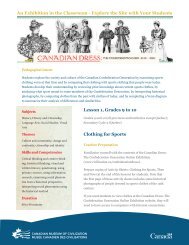Lesson Plan, Comparing Primary and Secondary Sources (pdf)
Lesson Plan, Comparing Primary and Secondary Sources (pdf)
Lesson Plan, Comparing Primary and Secondary Sources (pdf)
You also want an ePaper? Increase the reach of your titles
YUMPU automatically turns print PDFs into web optimized ePapers that Google loves.
<strong>Comparing</strong> <strong>Primary</strong> <strong>and</strong> <strong>Secondary</strong> <strong>Sources</strong><strong>Lesson</strong> <strong>Plan</strong>DescriptionStudents learn to differentiate between primary <strong>and</strong> secondary sources. Working ingroups, students will evaluate an example of both source types, considering theadvantages <strong>and</strong> disadvantages of using each in historical research. Students will becomeaware that there are different perspectives on historical events by critically examiningtheir sources. This lesson can be used as an introduction to a First World War unit.Recommended Grade RangeAll provinces <strong>and</strong> territories except Quebec: Grades 7 to 12,Quebec <strong>Secondary</strong> Cycles I-VObjectivesStudents will:• underst<strong>and</strong> the difference between primary <strong>and</strong> secondary sources;• brainstorm a list of document types in each category;• work individually <strong>and</strong> in groups to analyze critically historical sources;• consider the advantages <strong>and</strong> disadvantages of using both primary <strong>and</strong> secondarysources;• explain their findings to the class as part of a class discussion.Estimated Time2-3 class periodsMaterials Required• Internet/computer lab access for 1 class period;• Copies of the <strong>Primary</strong> Document Analysis Worksheet;• Copies of the <strong>Secondary</strong> Source Analysis Worksheet.<strong>Lesson</strong>Introduction:Ask students if they can define primary <strong>and</strong> secondary sources. Make note of theirdefinitions on the board. Summarize their ideas in a working definition for the class, orprovide students with an existing definition.A primary source provides a firsth<strong>and</strong> account of events recorded during or shortly afterthe events described occurred.
<strong>Comparing</strong> <strong>Primary</strong> <strong>and</strong> <strong>Secondary</strong> <strong>Sources</strong><strong>Lesson</strong> <strong>Plan</strong>A secondary source of information is one that was created later by someone who did notexperience first-h<strong>and</strong> or participate in the eventsAsk students to brainstorm types of documents they think would fit into each category.<strong>Primary</strong> sources might include diaries, letters, eyewitness testimonies, official reports,home videos, or speeches.<strong>Secondary</strong> sources might include textbooks, essays, scholarly articles, biographies, orencyclopaedias.Once you have determined that the class is comfortable with the definitions, organizestudents in small groups (3-4 students). Have each group select a primary sourcedocument from the archival documents section of the First World War web site, <strong>and</strong> asecondary source article from the site covering the same topic as their primary source.You may also choose to use the materials in the resource packs. Students should printthese out <strong>and</strong> return to the classroom. It will be helpful for each student in the group tohave a copy of the documents they have chosen.Distribute the Document Analysis Worksheet <strong>and</strong> <strong>Secondary</strong> Source Analysis Worksheetto each student, <strong>and</strong> have students individually complete both worksheets using theirchosen documents. Ask students to pay special attention to the similarities <strong>and</strong>differences in the perspectives provided by each source, <strong>and</strong> include examples/quotesfrom their documents where possible.Once students have individually completed their worksheets, distribute one blank copy ofeach worksheet to each group. Ask students to consolidate their results in the newworksheet, fleshing out their responses <strong>and</strong> discussing their answers as they work.Circulate throughout the class providing support <strong>and</strong> feedback.Reconvene the class <strong>and</strong> discuss students’ findings. What kind of information is providedby the primary source? Is it different from information provided by the secondary source?How? Which type of source do students think provides the most accurate information?Why?
<strong>Comparing</strong> <strong>Primary</strong> <strong>and</strong> <strong>Secondary</strong> <strong>Sources</strong><strong>Lesson</strong> <strong>Plan</strong>ConclusionOnce groups have summarized their findings, draw two tables on chart paper or theboard. One chart will be for primary sources, <strong>and</strong> one for secondary sources. Each chartshould have two categories: ‘Advantages’ <strong>and</strong> ‘Disadvantages’. Have students contributeideas for each category, <strong>and</strong> note these on the charts.Ask the class to consider the work of historians. Which sources do students thinkhistorians use most often? Why? How can primary <strong>and</strong> secondary sources be usedtogether?Assessment:Have the class h<strong>and</strong> in their group <strong>and</strong> individual worksheets. Answers should bethoughtful <strong>and</strong> analytical, <strong>and</strong>, where appropriate, include examples to support theirconclusions. Ideally, the group worksheets should combine the insights of all groupmembers.You may also wish to assign participation marks based on student contributions to classdiscussions <strong>and</strong> observations made during group work.Extension Activities:• Ask students to choose a First World War-related topic <strong>and</strong> build an annotatedbibliography on the subject using both primary <strong>and</strong> secondary sources.• Have students evaluate their textbooks by conducting further research on a topiccovered by the book using primary <strong>and</strong> secondary sources. Do they agree with theinterpretation of events provided by the textbook? Why or why not?• Using the First World War Photograph <strong>and</strong> Document Packages section of theCanadian War Museum’s Canada <strong>and</strong> the First World War Web site, direct studentsto use the information in the documents to tell the story of the event or phenomenapresented. Have students compare their interpretations - even if students are usingthe same facts, the final narrative may still be different.• Lead a class discussion about issues of perspective in sources of history. Talk aboutsome of the ways to gain awareness of bias or point of view <strong>and</strong> what role thisawareness may play in their own interpretations or conclusions.



